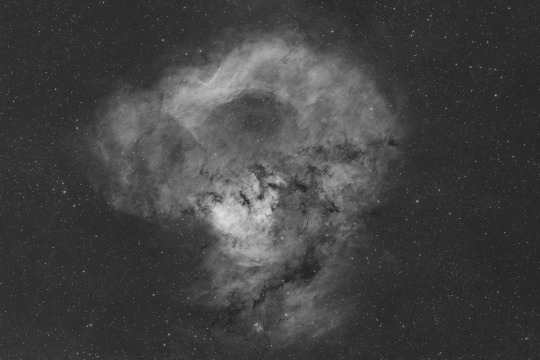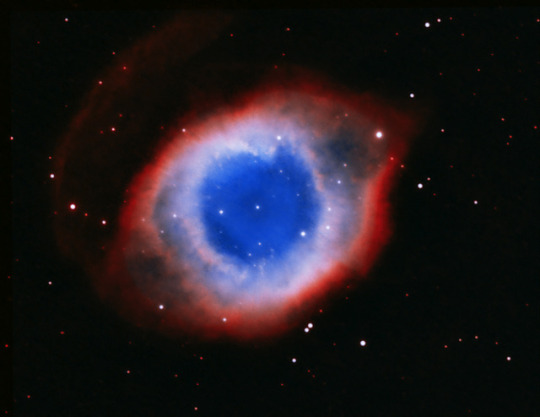#asi1600mm c
Explore tagged Tumblr posts
Text
Viel Nebula and Melotte 15 starless


2 notes
·
View notes
Text

First Light with the ZWO ASI2600MM Pro mono camera June and July consistently delivered terrible weather for astronomy. There was one clear-ish night somewhere in the middle of the waves of thunderstorms, torrential rain, and general cloudiness, but there was a nearly full moon, and a few hours of clear skies amid weeks of cloud wasn’t worth it. So I waited for the next opportunity. Last night, August 11th, I set up the Sky-Watcher mount with the William Optics SpaceCat and the new camera.
Here's the result of my first imaging run with the ZWO ASI2600MM Pro mono camera, cooled to -10C, Antlia 3nm Hydrogen-alpha Pro Imaging filter (2 inch). 52 x 300-second sub-exposures with minimal calibration (bias & dark, no flat frames). The ASI2600 is built around the monochrome version of the Sony IMX571 APS-C sized sensor, and although you can get away with 36mm unmounted filters, I went all the way to 2 inch mounted narrowband filters. And not even a hint of vignetting. I didn't use flat frames when stacking. So, am I impressed with the ZWO ASI2600MM Pro? Oh yeah.
I started narrowband imaging about ten years ago with Atik mono CCD cameras, moved through a couple QHYs, and settled on the ZWO ASI1600MM Pro—the smaller, older generation of this ASI2600. I've been using the 1600 for four or five years, and it was time to upgrade. The 2600 has been out for a little while—I'm not new to this camera but I'm really glad I made the jump.
Target Notes: NGC 7822, Cederblad 214, SH2-171 (the brighter emission nebula core) as well as the star cluster Berkeley 59. There are several long chains of clumps of dark nebulae, including LDN 1268, 1275, Dob 3637, 3627, 3623, many more. Nestled in that large band of dark nebulae toward the bottom is the reflection nebula GN 23.56.1. The very small circle of gray at the top left, blending in but dimmer than the nearby stars, with less contrast, is the planetary nebula Abell 1 (PLN 119+6.1). Find all of this—the nebulae and star forming complex in Cepheus near the edge of Cassiopeia.
3 notes
·
View notes
Video
IC405 - The Flaming Star Nebula by Alastair Woodward Via Flickr: Quick process of Ha, OIII and SII data (Ha-Green, OIII-Blue, SII-Red) Skywatcher 130PDS ASI1600mm-c (-15) Ha - 10 x 5 mins OIII - 10 x 5 mins SII - 10 x 5 mins (only 4 usable)
1K notes
·
View notes
Photo

Melotte 15 (the sequel) The heart of the heart nebula (ic 1805). Melotte 15 is a star cluster of young "O" type super giant stars at 1.5 million years old and a lovely nebula formed with those stars in an interstellar dance of gravity and radiation bringing ferocious stellar winds to shape the "swirly" nebula you see. Melotte 15 is named after its discoverer Philibert Jacques Melotte. This lovely wonder is located about 7500 light years away. "O" type stars are the brightest and most massive known stars ranging from 20-100x larger than the sun and have a lifespan of 3-6 million years This here is a bicolor rendition of the halpha and oxygen III regions and was shot in my backyard at bortle 7 (severe) light pollution. Data: 122x360s halpha, 100x600s Oiii Total integration= 28hrs 54min Equipment: 🔭Gso rc6, 📷Zwo asi1600mm-c, self modified zwo off axis guider using asi290mm mini for guiding, Stellardive heq5 mount, astrophysics cctd67 reducer, astrodon halpha, and Oiii in an 8 position electronic filter wheel. Qhy polemaster Sensor cooled to -20c Software: Sgpro, phd2, plate solve 2, stellarium, eqmod, and pixinsight. For now and always thanks for looking and always keep your head up to the stars! 🎶🎸🎶 https://www.instagram.com/p/BzCWoXIldP7/?igshid=28fawyqlqvnb
0 notes
Photo

M106 shot in LRGB. 4.5 hours of integration. Shot from CRO observatory with my C-9.25 and ASI1600MM
1 note
·
View note
Photo

Helix Nebula full resolution processed taken in my backyard
#helix neubla#nebula#ngc 7293#myphotos#backyard astronomy#stars#asi1600mm-c#orion#telescope#eye of sauron
20 notes
·
View notes
Photo

The Eye of Sauron... err ummm. The Helix Nebula! taken in my backyard
#helix nebula#nebula#ngc 7293#backyard astronomy#myphotos#eye of sauron#asi1600mm-c#astronomik#custom scientific#orion#telescope#neq6 pro#stars
4 notes
·
View notes
Photo

I’ve seen the Eye of Sauron from my backyard!
#BackyardAstronomy :)
#Helix Nebula#NGC 7293#myphotos#zwo#asi1600mm-c#orion refractor#neq6 pro#custom scientific#astronomik#backyard astronomy#eye of sauron#bicolor#nebula#stars#space
2 notes
·
View notes
Photo

M33 The Triangulum Galaxy Swipe to see annotated version and swipe again to see halpha star forming regions and nebulae! Full resolution in link on my page. One of the closest galaxies to us at about 3 million light years away located in the constellation Triangulum. M33 is quite the spiral galaxy as it has a good amount of bright nebulas in it as you can see the red "jewels" i managed to bring forth in this rendition. This galaxy is home to about 40 billion stars. Some sources state that it was "possibly" first dicovered by Italian astronomer Giovanni Battista Hodierna before 1654 and independently discovered by Charles Messier August 25/26th 1764. In September of 1784 William Herschel separately catalogued the brightest hydrogen alpha region as H III.150 which later on became known as NGC 604. Much like our other neighbor the Andromeda galaxy, M33 is also heading towards us on a collision course moving at a speed of 62K mph (100k kph). Nasa has added that if the halpha region NGC 604 was located at the same distance as the Orion Nebula (1344 ly away) that it would be the brightest part of our sky apart from the Moon. Scientists have estimated that NGC 604 is 100x larger than the Orion Nebula. This wonderful galaxy under dark skies can be seen with the naked eye, binoculars, small telesopes and more. In larger telescopes you can see NGC 604. Data: 54x600s halpha, 48x360s Luminance, 57x360s Red, 30x360s Green, 33x360s Blue. Total integration= 25hrs 48min Equipment: 🔭Gso rc6, 📷Zwo asi1600mm-c, self modified zwo off axis guider using asi290mm mini for guiding, Stellardive heq5 mount, astrophysics cctd67 reducer, astrodon halpha, and zwo LRGB filters in an 8x electronic filter wheel. Qhy polemaster Software: Sgpro, phd2, plate solve 2, stellarium, eqmod, and pixinsight. For now and always thanks for looking and always keep your head up to the stars! 🎶🎸🎶 #astrophotography #deepspace #nightsky #natgeospace #photography #space #longexpo #stars #followyourstars #universe #night #night_photography #astronomy #universetoday #woah #spacelife #science #texasphotographer #amateurphotography #nasa #narrowband #astrodon #amateurastrophotographyezine https://www.instagram.com/p/BqLbKE0BjTv/?igshid=hueuw1b7xlqi
#astrophotography#deepspace#nightsky#natgeospace#photography#space#longexpo#stars#followyourstars#universe#night#night_photography#astronomy#universetoday#woah#spacelife#science#texasphotographer#amateurphotography#nasa#narrowband#astrodon#amateurastrophotographyezine
0 notes
Photo

Melotte 15 (the sequel) The heart of the heart nebula (ic 1805). Melotte 15 is a star cluster of young "O" type super giant stars at 1.5 million years old and a lovely nebula formed with those stars in an interstellar dance of gravity and radiation bringing ferocious stellar winds to shape the "swirly" nebula you see. Melotte 15 is named after its discoverer Philibert Jacques Melotte. This lovely wonder is located about 7500 light years away. "O" type stars are the brightest and most massive known stars ranging from 20-100x larger than the sun and have a lifespan of 3-6 million years This here is a bicolor rendition of the halpha and oxygen III regions and was shot in my backyard at bortle 7 (severe) light pollution. Data: 122x360s halpha, 100x600s Oiii Total integration= 28hrs 54min Equipment: 🔭Gso rc6, 📷Zwo asi1600mm-c, self modified zwo off axis guider using asi290mm mini for guiding, Stellardive heq5 mount, astrophysics cctd67 reducer, astrodon halpha, and Oiii in an 8 position electronic filter wheel. Qhy polemaster Sensor cooled to -20c Software: Sgpro, phd2, plate solve 2, stellarium, eqmod, and pixinsight. For now and always thanks for looking and always keep your head up to the stars! 🎶🎸🎶 https://www.instagram.com/p/BzCWoXIldP7/?igshid=1jrgvbhce832y
0 notes
Photo

M33 The Triangulum Galaxy Swipe to see annotated version and swipe again to see halpha star forming regions and nebulae! Full resolution in link on my page. One of the closest galaxies to us at about 3 million light years away located in the constellation Triangulum. M33 is quite the spiral galaxy as it has a good amount of bright nebulas in it as you can see the red "jewels" i managed to bring forth in this rendition. This galaxy is home to about 40 billion stars. Some sources state that it was "possibly" first dicovered by Italian astronomer Giovanni Battista Hodierna before 1654 and independently discovered by Charles Messier August 25/26th 1764. In September of 1784 William Herschel separately catalogued the brightest hydrogen alpha region as H III.150 which later on became known as NGC 604. Much like our other neighbor the Andromeda galaxy, M33 is also heading towards us on a collision course moving at a speed of 62K mph (100k kph). Nasa has added that if the halpha region NGC 604 was located at the same distance as the Orion Nebula (1344 ly away) that it would be the brightest part of our sky apart from the Moon. Scientists have estimated that NGC 604 is 100x larger than the Orion Nebula. This wonderful galaxy under dark skies can be seen with the naked eye, binoculars, small telesopes and more. In larger telescopes you can see NGC 604. Data: 54x600s halpha, 48x360s Luminance, 57x360s Red, 30x360s Green, 33x360s Blue. Total integration= 25hrs 48min Equipment: 🔭Gso rc6, 📷Zwo asi1600mm-c, self modified zwo off axis guider using asi290mm mini for guiding, Stellardive heq5 mount, astrophysics cctd67 reducer, astrodon halpha, and zwo LRGB filters in an 8x electronic filter wheel. Qhy polemaster Software: Sgpro, phd2, plate solve 2, stellarium, eqmod, and pixinsight. For now and always thanks for looking and always keep your head up to the stars! 🎶🎸🎶 #astrophotography #deepspace #nightsky #natgeospace #photography #space #longexpo #stars #followyourstars #universe #night #night_photography #astronomy #universetoday #woah #spacelife #science #texasphotographer #amateurphotography #nasa #narrowband #astrodon #amateurastrophotographyezine https://www.instagram.com/p/BqLbKE0BjTv/?igshid=uz6bbnrdxde6
#astrophotography#deepspace#nightsky#natgeospace#photography#space#longexpo#stars#followyourstars#universe#night#night_photography#astronomy#universetoday#woah#spacelife#science#texasphotographer#amateurphotography#nasa#narrowband#astrodon#amateurastrophotographyezine
0 notes
Photo


IC 1848 (Soul Nebula) in HaRGB. 9.5 hrs of integration with a Canon 300mm f/2.8 lens and ASI1600MM-C
0 notes
Photo


M42 (Orion Nebula) in HaLRGB. 12 hrs of integration with a Canon 300mm f/2.8 lens and ASI1600MM-C
0 notes